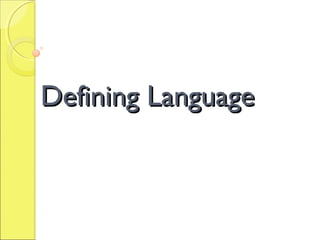
Lesson 1 defining language
- 2. Dictionary Definitions a) A system of communication with its own set of conventions or special words; b) Speech peculiar to an ethnic, national or cultural group; c) By extension, the articulate or inarticulate expression of thought and feeling by living creatures.
- 3. •Language is COMPLEX! •Language is separate from all other forms of communication. •Language is what makes humans, human.
- 4. The extended definition (c) the articulate or inarticulate expression of thought and feeling by living creatures is widely regarded as a far stretch of the concept of language and is a source of controversy amoung linguists
- 6. Language as HUMAN • The parrot can be taught to reproduce sound sequences. • It cannot be taught to formulate sentences on its own. • Animals use sound and movement to initiate mating but cannot convey how it feels about the shortage of food supplies.
- 7. Language as Systematic It uses various systems: ◦ Sound ◦ Grammar
- 8. SOUND Sound is a system that each language has patterns for that are recognizable to its speakers. Do you recognize any of these words? ◦ Cinquo ◦ Briskve ◦ Merci ◦ Gracias ◦ Froid Soundstake on meaning in a language only when they are combined in certain ways that are recognizable to the speakers.
- 9. GRAMMAR This is the set of rules that govern how the words of the language are put together to make meaning. “Often to goes he the market” Would not qualify as an English sentence However : “He often goes to the market.” Would be accepted as it is now placed in the correct order.
- 10. GRAMMAR Word order is critical to meaning. Consider the way in which a simple sentence can acquire different meanings depending on the word order. You are there. There you are! Are you there?
- 11. Activity: Choose the appropriate words to replace the word ‘goes’ in the sentence “He often goes to the market.” car, of, runs, circular, bright, pencils, there, but, rides You should notice that only a verb would be suitable in that word position.
- 12. Apart from having to use a particular type of word, in this case a verb, grammatical rules are even more specific and the space cannot be filled by just any verb.
- 13. Activity: Which of the following verbs would fit the sentence? “He often ________ to the market.” shuffles, kisses, jumps, dances, sits, cries, eats, sings, flies, hears
- 14. Each language has its own set of rules, which must be employed for the effective transfer of meaning.
- 15. Language as SYMBOLIC Ituses words as representations or symbols of ideas. In order for language to make sense there must be commonly understood or accepted meanings attributed to its symbols.
- 16. Consider the following words. What do they symbolize? Do you think all English speakers mean the same thing when they say those words? Sorrow anger disgust strength pride love embarrassment
- 17. Dictionariesare records of the symbolic meaning of words in a language.
- 18. Language as EVOLUTIONARY Language changes over time. The invention of new words takes place over time. Can you think of any words that was recently added to the English dictionary?
- 19. Activity 3: Home Assignment Try to find out when the following words became part of the English language: ◦ Computer ◦ Nuclear ◦ Aeroplane ◦ Television ◦ Atom ◦ genetics
- 20. Changes in meaning are another way in which language evolves. These changes occur when a significant group of persons persistently use a word (symbol) to mean something other than its traditionally accepted definition.
- 21. Changes in meaning WORD OLDER MEANING MODERN MEANING Gay Carefree, happy Homosexual Nice Stupid, foolish Pleasant, agreeable Girl Any young person Female young person Manufacture Make by hand Produce artificially by hand of machinery Tell Count Say, inform Meat Any food Food from animal flesh
- 22. Discuss with your classmates some words that you think are in the process of evolution or which have recently acquired new meanings. What may account for the changes?
- 23. SUMMARY Language is a system of communication with its own set of conventions or special words. Characteristics of language: ◦ Human ◦ Systematic ◦ Symbolic ◦ Evolutionary
- 24. Recap Quiz 1. Define language. 2. What is unique about language? 3. How is language systematic? 4. Why is word order critical to meaning in language? 5. What type of symbol is used for the English language? 6. Explain why a word of your choice has evolved through time.
